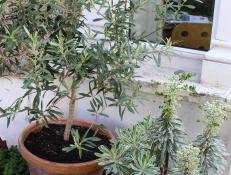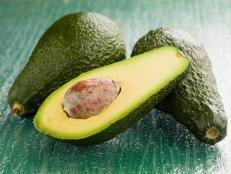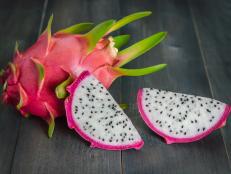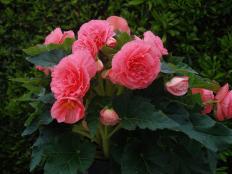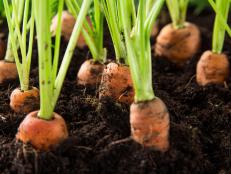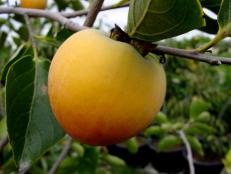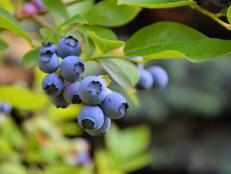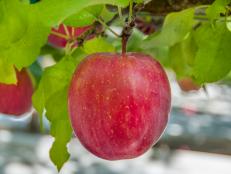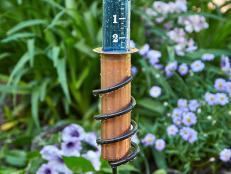How to Grow a Peach Tree
Learn how to grow a peach tree from a seed or young tree, and fill your shelves and freezer with delicious peach jams, pies and cobblers.

Bailey Nurseries, Inc.
Firm, sweet freestone peaches with top-notch flavor cover this tree, 'Flamin' Fury PF Lucky 13'. Hardy to USDA Gardening Zone 5, it grows 10 to 12 feet tall and resists bacterial spot disease.

Fresh peaches are unbeatable, and so are summer salads, crunchy crisps and other treats made with them. Once you know how to grow a peach tree, you'll have a beautiful, spring-flowering tree that bears sweet, sun-ripened fruits.
Native to China, peaches are known as stone fruits for their hard pits, or seeds. They're rich in minerals, antioxidants and vitamins. Peaches are part of a fruit-filled plant family that also includes plums, almonds, cherries, apricots and nectarines.
You can buy peach trees that are typically one or two years old from nurseries and garden centers. Most are grafted, which means two different trees have been grown together. This produces a new tree that bears better peaches and better resists pests, diseases and extremes of cold than the parent trees. You can also plant a peach seed, or pit.
Botanical Name: Prunus persica
Common Name: Peach tree
Bloom Time: Spring; usually pink or white flowers
Light Needs: Full sun
Hardiness Zones: 4-9; peach trees grow best in Zones 6-8
Height and Width: Dwarf or standards range from 4-25 feet tall and 5-25 feet wide
Growth Rate: Moderately fast, maturing in three or four years
Peach trees need a period of winter chill, known as chilling hours, to produce fruit. The number of hours depends on the variety, so choose one recommended for your region. Most need at least 600 hours of temperatures at 45 degrees or lower. Without enough hours, the trees won't bear or the peaches will be low quality.
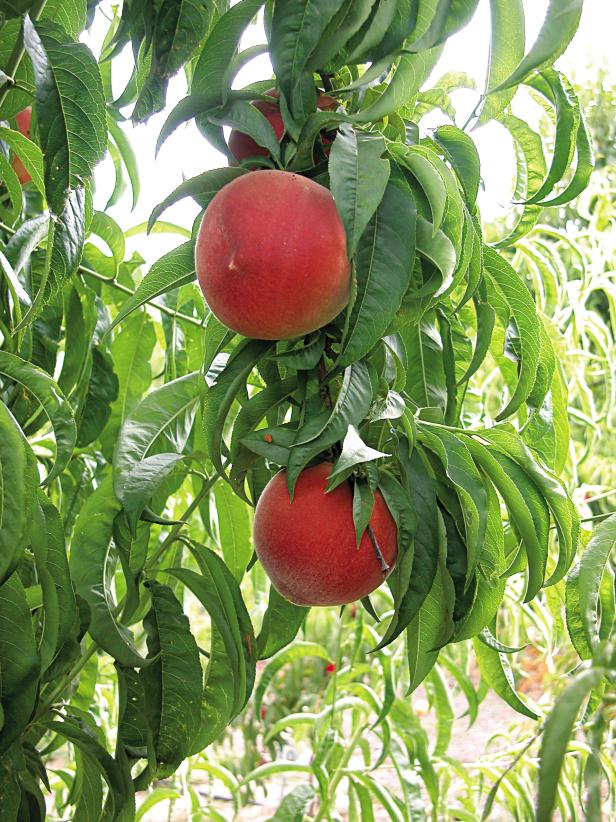
Courtesy of Park Seed, parkseed.com
You can expect your peach tree to grow 18 to 24 inches a year and take three to four years to produce fruit.
Properly caring for a peach tree will give you fruits in two to four years. Most commonly grown varieties are self-pollinating, but read the tag on yours to see if you need more than one.
How to Grow a Peach Tree From Seed
- Clean the pit with a dry, soft brush.
- To prevent mold, dip the pit into a solution of one part bleach to 10 parts water. Let it air dry and apply a fungicide as directed on the product's label.
- The pit needs to stay at 35 to 50 degrees for about four months, so put it in the refrigerator but away from other fruits that can give off ethylene gas and inhibit sprouting.
- The actual seed is inside the wrinkled covering that you see. After you take the pit out of the refrigerator, you can speed up germination by cracking that covering — called the endocarp — with pliers or a nutcracker and then removing the small, smooth seed inside. This step is optional, however. You can grow a peach tree from a pit that still has the endocarp.
- Fill a container at least 12 inches deep with soil-free potting mix, vermiculite or sphagnum moss and plant the seed one inch deep. Keep it moist and in a warm spot until it germinates in 4 to 6 weeks.
- After all danger of frost has passed and your seedling has at least two sets of true leaves, acclimate it to the outdoors. On its first day outside, put it in a sheltered spot for two hours and bring it back in. The next day, leave it out for three hours. Add an hour each day until it's used to the sun, wind and temperature.
Note: Most store-bought peaches come from grafted trees so you probably won't know what variety your pit came from. A tree grown from the pit of a grafted tree may not fruit for years, if ever, or produce poor peaches. But with luck, you can get a nice tree.
How to Grow a Peach Tree From a Pit — Another Way
You can also grow a peach tree from a pit by simply cleaning off the flesh and leaving the pit to dry in a well-ventilated place. Again, removing the endocarp is optional.
- Put the pit in an airtight container in the fridge.
- In the fall, plant it three inches deep in the ground. Mother Nature will keep it cold.
- If desired, transplant the seedling in the spring after all chance of frost has passed and when it has two sets of true leaves.
How to Plant a Peach Tree
Plant peach trees outside when they're dormant, in late winter or early spring.
- Dig a hole several inches wider and deeper than the tree's container.
- Make a small mound of soil in the center of the hole; loosen the tree's roots and drape them over the mound.
- If the roots have grown in a circle, cut them with clean shears, but don't cut more than necessary.
- Keep the tree's graft union — or scion — two to three inches above the soil. The scion looks like a lump or raised area where two trees were grafted together.
- Backfill the hole, gently firm the soil and water thoroughly.
How to Grow a Peach Tree
Caring for a peach tree takes more effort than most ornamental trees, but the juicy, delicious fruits are the payoff.
Light Needs
Whether you're planting a young tree or one grown from a pit, give it a spot with full sun.
Soil
Peach trees prefer moderately fertile soil that drains easily and has a pH of 6 to 6.5.
How to Water
If rainfall is lacking, water new trees deeply two or three times a week to keep the soil evenly moist. Use a soaker hose or irrigation system so the water doesn't run off. If there's an inch of rainfall over a 10-day period, you can usually skip watering.
Beginning in the second year, peach trees need 1 to 1 1/2 inches of water per week from rainfall and/or an irrigation system or soaker hose. Mature trees need at least 36 inches of water per year; give them about 35 to 40 gallons a day during the hot months of July and August.
Water more often in dry spells and hot weather and less in rainy spells. Watering is especially important during the last month the peaches are ripening on the tree. Soil type can affect watering; sandy soils don't hold moisture well as well as loamy ones. Dwarf trees need less water than standard, mature trees.
Apply an organic mulch out to the tree's drip line to help hold moisture in the soil and prevent weeds, but keep it at least six inches away from the trunk.
Fertilizer Needs
Six weeks after planting, spread one pound of a balanced 10-10-10 fertilizer around the root zone, keeping it at least 18 inches away from the trunk.
Apply 3/4 pounds of nitrogen fertilizer once in the spring and once in the early summer of the second year.
In the early spring of the third year, when new growth begins, apply another pound of nitrogen fertilizer.
Stop fertilizing 2 months before the first expected fall frost. Don't fertilize when the peaches are maturing.
How Long Does It Take a Peach Tree to Grow?
Peach trees grow 18 to 24 inches a year and take three to four years to produce fruit. The weather, pests and other factors can affect when and how much they bear.
How Big Do Peach Trees Get?
Standard-size peach trees grow to 25 feet tall and wide, so plant them 15 to 20 feet apart. Dwarf types mature about 5 feet tall and wide. Space them 10 to 12 feet apart.
How Long Do Peach Trees Live?
As a rule of thumb, peach trees live about 10 to 12 years. Some sources say they can live 15 to 20 years. They tend to bear mostly heavily starting around six years old. Weather, pests, diseases and the kind of care they're given can affect their life spans.
How to Grow a Peach Tree in a Container
Start by adding a layer of gravel or pebbles to the bottom of a 7- to 10-gallon container with drainage holes. Fill it with good potting soil, plant a dwarf peach tree and water it thoroughly. When it starts to become root bound, move it into a 10- to 15-gallon container or half-whiskey barrel with drainage holes. Again, use potting soil. Water deeply about every 5 days in the spring and more often when the weather heats up. Keep the tree in full sun for at least six hours a day. Use a liquid fertilizer for fruit trees as directed on the product label. Reduce watering and fertilizing in late August or early September as winter approaches. Move the container into a garage or other sheltered location when hard freezes hit.
Clingstone vs. Freestone Peaches
Peaches can be clingstones, which means their flesh clings to the pits, or freestones, with pits that easily pull away from the flesh. You can't tell the difference by looking; you have to open the peach or know the variety. Most gardeners grow freestones. There are also semi-clingstone (also called semi-freestone) peaches. The flesh of these hybrid peaches is easier to emove from their pits than true clingstones.
How to Prune a Peach Tree
Wait until your tree is at least three years old to prune heavily. Until then, prune only to create its basic shape. Prune once a year in the spring when the buds start to swell and you see a little pink color.
Start by choosing 3 to 5 side branches spaced as evenly as possible around the trunk. They should be growing upward and at approximately 45-degree angles from the trunk. (Branches with narrow crotches — those growing at less than 45-degree angles — may split once they're heavy with fruit.) The 3 to 5 branches should be 18 to 36 inches from the ground.
Use a pruning saw to remove any large branches in the center of the tree and any that will compete with your chosen branches. Your goal is to make an open, vase-like shape in the center of the tree. Think of the 3 to 5 branches as the sides of the vase. The open vase will let in air and sunlight and make it easier to pick the peaches or treat for pests and diseases.
At any time of year, remove dead, diseased, or broken wood and suckers coming from the base of the tree. Also, remove any new shoots growing straight up or down. The rest of the new, reddish shoots will produce peaches. Trim them to 18 inches long by cutting 1/4 inch above outward-facing buds. Trim any tall branches so you can easily harvest from them unless you plan to use a ladder.
Peaches often drop naturally. Some wouldn't have matured anyway and the trees can't support all the fruits they set. Thin the peaches by removing them to every 6 to 8 inches before they're as big as a dime.
Prune about 40 percent of a mature tree every year to promote new growth. Peach trees take several years to produce fruit and bear smaller crops as they age, so some gardeners plant new trees every five or six years to ensure a steady supply of fruit.
Caring for a Peach Tree With Pests or Diseases
Peach trees are prone to a number of problems and caring for a peach tree means addressing those problems as soon as possible. If you're not sure what's wrong, talk to your county extension service agent. They may recommend a spraying schedule or other periodic or preventative treatment. If you use chemicals, read and follow all label directions carefully.
- Sticky or mottled leaves can be signs of aphids or spider mites. Try knocking these pests off with a spray of water from your hose and repeat as needed. Step up to an insecticidal soap spray if they persist.
- Brown rot is a fungal disease that causes peaches to rot, especially in wet or humid weather. Treat with a fungicide labeled for this problem and remove diseased and fallen fruits.
- Peach tree borers are wasp-like moths that lay eggs on tree bark in the fall. The grubs hatch and tunnel into the tree to feed. They make a sawdust-like waste called frass and leave jelly-like sap around their holes. Stick a wire into the holes to kill the grubs or use an insecticidal soap.
- Powdery mildew looks like fine, white fuzz on peaches and makes leaves turn brown or become deformed. Combat this disease with a copper-based fungicide in late fall or early spring.
- Yellow leaf veins signal a lack of iron, or iron in the soil that isn't being absorbed. Add chelated iron, following package directions for how much and how to apply it.
- Yellowing leaves all over can indicate root or crown rot.
- Leaf holes can be caused by paper wasps or a fungal disease, coryneum blight, also called shothole blight. It causes purplish-black spots that become "shotgun" holes. Prune out and destroy damaged twigs and branches or use a fungicide labeled for this problem.
- Paper wasps aren't all bad; they eat other insect pests. But they can damage your peaches by feasting on them and threaten anyone who gets near. Keep fruits harvested, pick up fallen peaches and/or use an insecticidal spray labeled for their control. A dormant oil spray applied in late winter or early spring can help prevent them from overwintering.
- If your trees aren't bearing, they may be immature. Be sure you haven't applied too much nitrogen, which promotes foliage at the expense of fruits, and that you aren't pruning too heavily. If pollinators are scarce, use a soft brush to transfer pollen among the blooms to help fruits form.
Your local extension service can tell you more about caring for peach trees.
How to Overwinter a Peach Tree
Cold snaps can damage blooms and buds resulting in a loss of peaches, so protect your trees during extreme cold or extended periods of cold. When there's a hard freeze, wrap them in burlap or heavy cloth and mulch around the base. Remove the wrapping when the temperatures rise.
Commonly Grown Peach Tree Varieties
These varieties are popular with backyard gardeners, but remember to plant trees that will get enough chilling hours in your region. All of these are self-pollinating.
'Redhaven' - Medium-sized freestone peaches with red skins and yellow, creamy flesh. Grows to 15 feet. Hardy in Zones 5 to 8. Pink blooms.
'Ruby Prince' - Large, yellow skins with a red blush, yellow flesh and semi-clingstone pits. Hardy in Zones 5 to 8 and reaches 12 to 15 feet tall. Pink flowers.
'Elberta' - Big, juicy yellow fruits with freestones. Hardy in Zones 5 to 9 and grows 8 to 25 feet tall. Purple blooms.
'Contender' - Red-orange skins and yellow flesh. Cold-hardy and frost tolerant, this freestone tree is good for northern regions. Hardy in Zones 4 to 9. Blooms pink and grows 12 to 15 feet.






